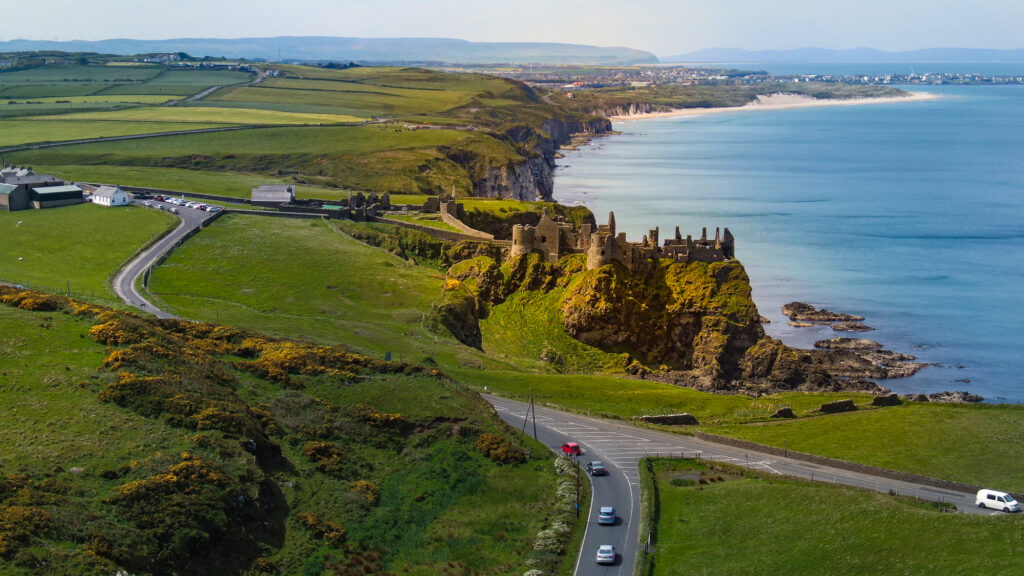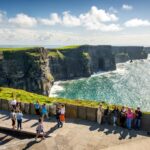Embark on a breathtaking adventure along Ireland’s stunning Wild Atlantic Way coastline, a journey that will leave you awe-inspired and craving for more. This epic road trip unveils breathtaking vistas, rugged cliffs, hidden coves, and charming coastal villages, immersing you in the country’s natural beauty and rich culture. As you traverse this 1,500-mile route, you’ll encounter untamed landscapes that will take your breath away and spark a sense of wanderlust within you. Feel the wind in your hair as you drive along the dramatic cliffs of Slieve League, higher than the cliffs of Moher, or soak up the tranquility of the remote Connemara region, with its enchanting lakes and mountains. Along the way, stop by quaint Irish pubs to indulge in traditional music, warm hospitality, and mouthwatering cuisine. Whether you’re an adventure seeker, a nature lover, or a history enthusiast, Ireland’s Wild Atlantic Way coastline promises an unforgettable experience. So, buckle up and get ready to be captivated by the magnificence of this coastal road trip.
Route Overview: A guide to the Wild Atlantic Way
The Wild Atlantic Way is a coastal route that stretches along Ireland’s western coastline, starting from the Inishowen Peninsula in County Donegal and ending in Kinsale, County Cork. Spanning over 1,500 miles, this route showcases some of the most breathtaking landscapes in Ireland. Along the way, you’ll encounter rugged cliffs, golden sandy beaches, ancient castles, and vibrant coastal villages.
One of the highlights of the route is the Cliffs of Moher, located in County Clare. Rising 700 feet above the Atlantic Ocean, these majestic cliffs offer panoramic views that will leave you speechless. Another must-see destination is the Ring of Kerry, a picturesque drive that takes you through stunning coastal scenery, charming towns, and historic sites.
To fully experience the Wild Atlantic Way, it is recommended to allocate at least two weeks for the journey. This will allow you to explore the route at a leisurely pace and take in all the beauty it has to offer. However, if you’re short on time, you can still enjoy a shorter section of the route and experience its magic.
Must-Visit Destinations: Highlighting the top attractions along the route
Along the Wild Atlantic Way, there are numerous must-visit destinations that will leave you in awe. One such destination is the Dingle Peninsula, located in County Kerry. Known for its rugged beauty and vibrant culture, this peninsula offers a unique blend of stunning landscapes, ancient ruins, and lively pubs. Be sure to drive along Slea Head, a scenic route that offers breathtaking views of the Atlantic Ocean and the Blasket Islands.
Another must-visit destination is the Giant’s Causeway in County Antrim. This UNESCO World Heritage Site is famous for its hexagonal basalt columns, formed by volcanic activity millions of years ago. Take a walk along the dramatic coastal cliffs and marvel at the natural wonder that is the Giant’s Causeway.
As you continue your journey, make a stop at the picturesque town of Westport in County Mayo. With its colorful Georgian buildings and lively atmosphere, Westport is a charming place to explore. Don’t miss the opportunity to climb Croagh Patrick, Ireland’s holy mountain, which offers stunning panoramic views of Clew Bay and the surrounding countryside.
Planning Your Trip: Tips for organizing your road trip
Planning a road trip along the Wild Atlantic Way requires careful preparation to ensure a smooth and enjoyable journey. Here are some tips to help you organize your trip:
- Research and Map Out Your Route: Before setting off, spend some time researching the route and identifying the places you want to visit. Use a map or a GPS device to plan your itinerary, taking into account the distances between each destination and the time it will take to travel.
- Allow for Flexibility: While it’s important to have a rough itinerary, be open to making changes along the way. The beauty of a road trip is the freedom to explore and discover hidden gems. Leave some room in your schedule for spontaneous detours and unexpected discoveries.
- Book Accommodation in Advance: During peak tourist seasons, it’s advisable to book accommodation in advance, especially in popular tourist areas. Consider staying in guesthouses or B&Bs to experience the warm Irish hospitality.
- Pack for All Weather Conditions: Ireland’s weather can be unpredictable, so it’s essential to pack clothing suitable for all conditions. Be prepared for rain by bringing waterproof jackets and sturdy walking shoes. Don’t forget sunscreen and hats for sunny days.
- Familiarize Yourself with Driving Regulations: If you’re not from Ireland, familiarize yourself with the country’s driving regulations before embarking on your road trip. In Ireland, driving is on the left side of the road, and speed limits are indicated in kilometers per hour.
Remember, a road trip is not just about the destination; it’s about the journey itself. Enjoy the freedom of the open road, immerse yourself in the stunning landscapes, and embrace the adventure that awaits you along Ireland’s Wild Atlantic Way.
Best Time to Visit: Exploring the ideal seasons for a road trip
The best time to visit the Wild Atlantic Way depends on your preferences and what you want to experience during your road trip. Here’s a breakdown of the seasons and what they offer:
- Spring (March to May): Spring is a beautiful time to visit the Wild Atlantic Way as the countryside bursts into life with blooming flowers and lush greenery. The weather is mild, although rain showers are common. This is a quieter time to visit, with fewer tourists, allowing you to enjoy the attractions at your own pace.
- Summer (June to August): Summer is peak tourist season along the Wild Atlantic Way, with long daylight hours and warmer temperatures. The coastal towns come alive with festivals and events, and the beaches are perfect for swimming and water sports. However, be prepared for larger crowds and higher prices.
- Autumn (September to November): Autumn brings a stunning display of colors to the landscape, as the leaves turn shades of red, orange, and gold. The weather is mild, and the crowds start to thin out, making it a great time to enjoy the beauty of nature in a more peaceful setting.
- Winter (December to February): Winter is the quietest time to visit the Wild Atlantic Way, with fewer tourists and lower prices. While the weather can be cold and wet, there is a certain charm to exploring the rugged coastline in the dramatic winter light. It’s also the best time for storm watching, as the Atlantic Ocean churns with powerful waves.
Ultimately, the best time to visit the Wild Atlantic Way depends on your personal preferences. Consider what activities and experiences you want to have during your road trip and choose the season that aligns with your interests.
Scenic Drives and Stopovers: Uncovering the most picturesque routes and places to stay
The Wild Atlantic Way offers some of the most scenic drives in the world, with breathtaking vistas at every turn. Here are a few of the most picturesque routes and stopovers along the way:
- The Ring of Kerry: This iconic route takes you on a 179-kilometer journey through some of the most stunning landscapes in County Kerry. From the towering mountains of the MacGillycuddy’s Reeks to the picturesque lakes of Killarney National Park, every mile of this drive is a feast for the eyes. Make a stop in the charming town of Killarney and explore the historic Muckross House and Gardens.
- The Connemara Loop: Located in County Galway, the Connemara Loop is a scenic drive that showcases the rugged beauty of the Connemara region. Drive along the shores of Lough Corrib and Lough Mask, and marvel at the majestic Twelve Bens mountain range. Stay in the town of Clifden and enjoy traditional music sessions in the local pubs.
- The Causeway Coastal Route: This route takes you along the stunning coastline of County Antrim, with the highlight being the Giant’s Causeway. Take a detour to visit the Carrick-a-Rede Rope Bridge and the Dark Hedges, made famous by Game of Thrones. Stay in the vibrant city of Belfast and explore its rich history and cultural attractions.
When it comes to accommodation along the Wild Atlantic Way, there are plenty of options to suit every budget and preference. From luxury hotels to cozy B&Bs and self-catering cottages, you’ll find a wide range of choices. Consider staying in traditional Irish pubs that offer rooms, where you can experience the warmth of Irish hospitality and enjoy live music in the evenings.
Adventure Activities: Thrilling experiences along the coastline
For adventure seekers, the Wild Atlantic Way offers a plethora of thrilling activities that will get your adrenaline pumping. Here are some of the top adventure experiences along the coastline:
- Surfing in County Donegal: With its exposed coastline and powerful waves, County Donegal is a surfer’s paradise. Head to the town of Bundoran, known as the surf capital of Ireland, and catch some waves at Tullan Strand or Rossnowlagh Beach. Whether you’re a beginner or an experienced surfer, there are surf schools and rental shops to cater to all levels.
- Sea Kayaking in County Kerry: Explore the stunning coastline of County Kerry from a different perspective by embarking on a sea kayaking adventure. Paddle through crystal-clear waters, explore hidden caves, and get up close to wildlife such as seals and dolphins. There are guided tours available for all skill levels, making it a great activity for both beginners and experienced kayakers.
- Hiking in County Mayo: Lace up your hiking boots and conquer the challenging trails of County Mayo. Climb Croagh Patrick, Ireland’s holy mountain, and enjoy panoramic views of Clew Bay and the surrounding countryside. For a more leisurely hike, explore the beautiful trails of Ballycroy National Park or the Great Western Greenway, a 42-kilometer cycling and walking route.
- Coasteering in County Clare: For the ultimate adrenaline rush, try coasteering in County Clare. This adventure activity involves swimming, climbing, and cliff jumping along the rugged coastline. Explore sea caves, traverse rocky cliffs, and jump into the Atlantic Ocean under the guidance of experienced instructors.
These are just a few examples of the adventure activities available along the Wild Atlantic Way. Whether you’re into water sports, hiking, or extreme activities, there’s something for everyone to enjoy along this stunning coastline.
Local Cuisine and Culture: Sampling traditional Irish dishes and immersing in the local heritage
No road trip along the Wild Atlantic Way is complete without indulging in the local cuisine and immersing yourself in the rich Irish culture. Here are some must-try dishes and cultural experiences along the route:
- Traditional Irish Stew: Warm up with a hearty bowl of traditional Irish stew, made with tender lamb, potatoes, carrots, and onions. This comforting dish is the perfect meal after a day of exploring the rugged coastline. Pair it with a pint of Guinness for an authentic dining experience.
- Seafood Chowder: Along the Wild Atlantic Way, you’ll find an abundance of fresh seafood. Don’t miss the opportunity to try a bowl of creamy seafood chowder, filled with mussels, clams, fish, and potatoes. Enjoy it with freshly baked soda bread for a taste of the sea.
- Traditional Music Sessions: Irish music is renowned worldwide for its lively rhythms and heartfelt melodies. Visit a local pub along the route and experience a traditional music session, where local musicians gather to play traditional tunes. Tap your feet to the music and join in the merry atmosphere.
- Ancient Castles and Historic Sites: Ireland is steeped in history, and the Wild Atlantic Way is dotted with ancient castles and historic sites. Explore the iconic Blarney Castle in County Cork and kiss the Blarney Stone for the gift of eloquence. Visit the ancient monastic site of Skellig Michael, a UNESCO World Heritage Site, and marvel at its unique stone beehive huts.
Immerse yourself in the local culture by engaging with the friendly locals, attending cultural events, and visiting museums and galleries. The Wild Atlantic Way offers a unique opportunity to experience the warmth and hospitality of the Irish people while learning about their rich heritage.
Packing Essentials: What to bring for a comfortable and enjoyable road trip
To ensure a comfortable and enjoyable road trip along the Wild Atlantic Way, it’s important to pack the right essentials. Here’s a list of items to consider:
- Waterproof Jacket: Ireland’s weather can be unpredictable, so a waterproof jacket is essential to keep you dry during rain showers. Look for a lightweight and breathable jacket that can be easily packed.
- Comfortable Walking Shoes: With so much natural beauty to explore, comfortable walking shoes are a must. Opt for waterproof shoes with good traction to handle various terrains.
- Layers of Clothing: Ireland’s weather can change throughout the day, so it’s advisable to dress in layers. Pack lightweight, breathable clothing that can be easily layered for warmth or removed if the weather gets warmer.
- Sunscreen and Hat: Even on cloudy days, the sun’s rays can still be strong. Protect your skin by packing sunscreen with a high SPF and a wide-brimmed hat to shield your face from the sun.
- Travel Adapter: Ireland uses the three-prong Type G plug, so if you’re traveling from a different country, be sure to pack a travel adapter to charge your electronic devices.
- Snacks and Water: While there are plenty of restaurants and cafes along the route, it’s always a good idea to have some snacks and water on hand, especially during long stretches of road without many amenities.
- Camera and Binoculars: The Wild Atlantic Way offers countless photo opportunities, so don’t forget to pack your camera to capture the stunning landscapes. Binoculars are also handy for spotting wildlife and taking in distant views.
Remember to pack light and only bring the essentials to avoid unnecessary clutter in your vehicle. Leave room for souvenirs and mementos that you’ll undoubtedly collect along the way.
Conclusion: Embracing the beauty and adventure of Ireland’s Wild Atlantic Way
In conclusion, a road trip along Ireland’s Wild Atlantic Way coastline promises an unforgettable adventure filled with breathtaking landscapes, vibrant culture, and thrilling experiences. From the dramatic cliffs of Moher to the charming coastal villages, every mile of this 1,500-mile route offers something special.


